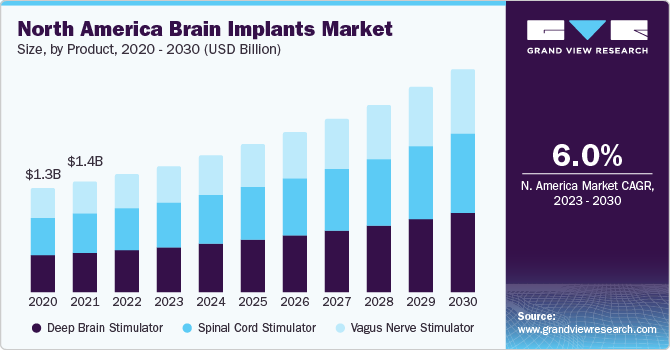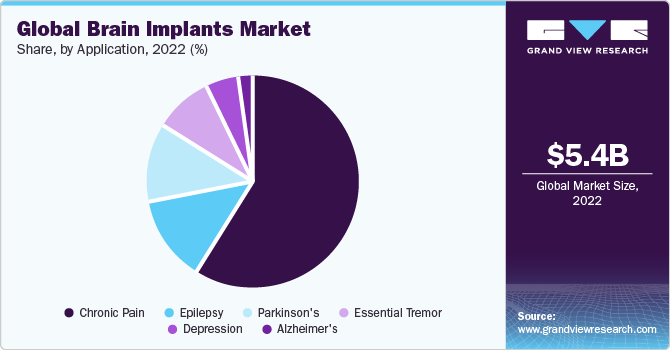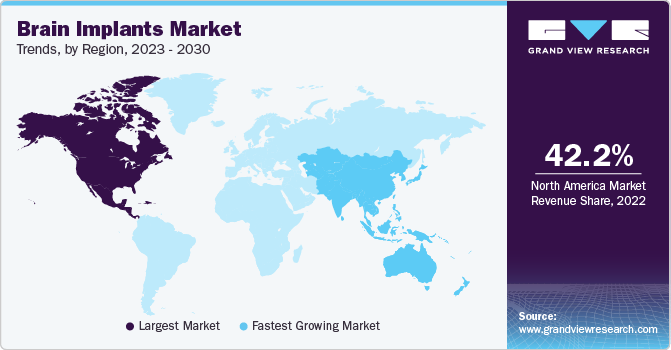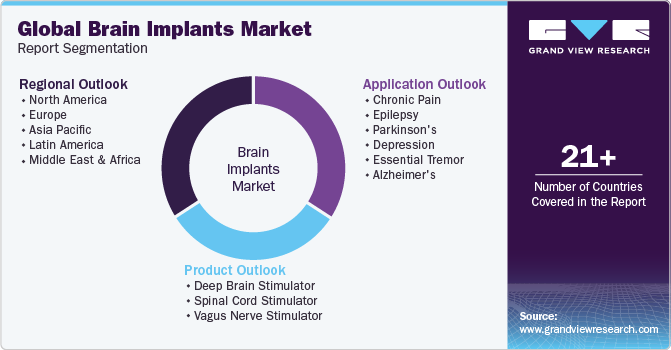- Home
- »
- Medical Devices
- »
-
Brain Implants Market Size, Share & Growth Report, 2030GVR Report cover
![Brain Implants Market Size, Share & Trends Report]()
Brain Implants Market Size, Share & Trends Analysis Report By Product (Deep Brain Stimulator, Spinal Cord Stimulator), By Application (Chronic pain, Epilepsy, Parkinson's, Depression, Essential Tremor), By Region, And Segment Forecasts, 2023 - 2030
- Report ID: GVR-2-68038-311-9
- Number of Report Pages: 120
- Format: PDF, Horizon Databook
- Historical Range: 2018 - 2021
- Forecast Period: 2023 - 2030
- Industry: Healthcare
Brain Implants Market Size & Trends
The global brain implants market size was valued at USD 5.40 billion in 2022 and is anticipated to grow at a CAGR of 9.7% from 2023 to 2030. The increasing incidence of neurological conditions such as Parkinson's, Alzheimer's, and epilepsy, coupled with increasing awareness regarding brain implant benefits and positive research outcomes, are among the major factors driving the growth of the overall market. For instance, according to Parkinson's Foundation 2022 study, approximately 90,000 individuals are diagnosed with Parkinson's disease in the U.S. each year. This marks a significant 50% rise from the earlier estimated figure of 60,000 yearly diagnoses. In simpler terms, this research shows that the number of new Parkinson's disease cases identified annually has increased by half compared to previous estimates.

The increasing prevalence of neurological disorders is a high-impact rendering driver for the market. For instance, according to the Pan American Health Organization (PAHO), in 2019, neurological conditions contributed to 533,172 deaths across a specific region. Among these deaths, 40% (213,129) were among men, while 60% (320,043) were among women. The age-standardized death rate, which adjusts for population differences, stood at 32.9 deaths per 100,000 individuals. When looking at gender-specific rates, it was 33.1 deaths per 100,000 for men and slightly lower at 32.2 deaths per 100,000 for women. These standardized rates showed considerable variation between countries, ranging from a higher rate of 47.4 deaths per 100,000 in the U.S. to a lower rate of 6.6 deaths per 100,000 in Venezuela. In essence, this data highlights the impact of neurological conditions on mortality within this particular region, underscoring differences between genders and countries.
Moreover, the growing global geriatric population and increase in the incidence of target diseases, especially Parkinson's, epilepsy, and Alzheimer's, as well as high unmet medical needs, has increased the demand for brain implants. The growing base of the aging population is more prone to Parkinson's disease. Individuals who have Parkinson's are not able to release adequate dopamine in the brain, which leads to walking problems, tremors, and stiffness, among other conditions. For instance, according to the World Health Organization (WHO), epilepsy affects approximately 50 million individuals worldwide, establishing it as one of the most prevalent neurological disorders on a global scale. An overwhelming 80% of those affected by epilepsy reside in countries with limited economic resources. Studies suggest that about 70% of individuals living with epilepsy could lead a life free from seizures if they receive an accurate diagnosis and appropriate treatment. The likelihood of premature death is elevated up to threefold among people with epilepsy compared to the general population. Shockingly, three out of four individuals with epilepsy in low-income countries lack access to necessary treatment. Moreover, many regions worldwide witness people with epilepsy and their families encountering social stigma and unjust treatment.
Furthermore, the introduction of advanced technologies such as MRI safety-enabled brain implants by Medtronic and the launch of transdermal neuromodulation technology (introduced by Neurowave Medical Technologies) is further anticipated to drive the market. In addition, technologies such as motor neuron prostheses, microelectrode arrays, and Brain-Computer Interfaces (BCIs) exhibit benefits such as improved patient mobility profile. This advancement acts as a high-impact-rendering driver for the market. For instance, Neuralink is a neurotechnology company founded by Elon Musk that is developing brain implants that can be used to treat various neurological disorders, including paralysis, Alzheimer's disease, and Parkinson's disease. Neuralink's implants are designed to be minimally invasive and can be implanted in the brain using a surgical robot. The implants can also record and stimulate brain activity, which could be used to restore lost function or control prosthetic devices.
Furthermore, the increasing number of research activities leading to technological breakthroughs is expected to witness lucrative growth opportunities in the market for brain implants. These include self-charging implants and memory chips that are anticipated to provide the market with growth opportunities over the forecast period. For instance, a study conducted by researchers at the University of California, where the study found that a brain implant called a "memory prosthesis" can improve memory in people with damaged brains. The memory prosthesis is a small device implanted in the hippocampus, an important part of the brain for memory. The device records electrical activity in the hippocampus and then uses this activity to stimulate the hippocampus in a way that helps to improve memory.
Application Insights
The chronic pain segment accounted for the largest revenue share of 58.5% in 2022 owing to an increase in the incidence of chronic pain has created clinical urgency for incorporating long-term solutions. For instance, according to the Centers for Disease Control and Prevention (CDC), between 2019 and 2021, chronic pain affected a portion of adults in the U.S., with numbers ranging from 20.5% to 21.8%, and severe chronic pain affected a smaller group, with numbers ranging from 6.9% to 7.8%. In 2021, around 51.6 million adults (20.9%) experienced chronic pain, while 17.1 million (6.9%) had severe, high-impact chronic pain. Some groups experienced higher rates of chronic pain. Moreover, American Indian/Alaska Native adults, those who identified as bisexual, and divorced or separated adults had higher rates of chronic pain. The same was observed for high-impact chronic pain.

The Parkinson's segment is expected to grow at the fastest CAGR of 10.7% during the forecast period owing to the increasing number of the geriatric population prone to conditions such as Parkinson's and Alzheimer's diseases. For instance, according to CDC, Alzheimer's disease is the most common type of dementia. Presently, roughly 5.8 million people in the U.S. have Alzheimer's disease and related forms of dementia. This includes around 5.6 million individuals aged 65 and above and approximately 200,000 individuals under 65 with early-onset Alzheimer's. Projections suggest that by 2060, the number of Alzheimer's cases could rise to about 14 million individuals, with minority groups experiencing a greater impact.
Product Insights
The deep brain stimulators segment accounted for the largest revenue share of 36.7% in 2022 attributed to its use in various applications in neurological disorders. The growing adoption of DBS for treating various neurological disorders, including obsessive-compulsive disorder, Parkinson's disease, dystonia, essential tremor, epilepsy, and Alzheimer's disease, is a key growth driver of this segment. In addition, growing awareness about neurological movement disorder treatment among patients is anticipated to trigger the growth of this segment. For instance, according to the American Association of Neurological Surgeons, dystonia is a complicated problem in the brain that makes muscles move in strange ways without control. About 250,000 people in the U.S. have dystonia, making it the third most common movement issue, like shaking or Parkinson's disease.
The vagus nerve stimulator segment is expected to grow at the fastest CAGR of 10.1% during the forecast period owing to the factors such as applications in the treatment of various disorders such as anxiety, migraines, fibromyalgia, tinnitus, and obesity. It is mainly used to deliver electrical impulses to the vagus nerve. In addition, product launches with advanced technology are enhancing the quality of therapy. For instance, according to the American Migraine Foundation, In the U.S., about 37 million people are impacted by migraine, making it a significant health concern. It ranks as the third primary cause of disability in the country. Migraine is notably more common in women, three times more prevalent than men. The typical age for migraine onset is approximately 16 years old. A small percentage, around 2%, of migraine sufferers deal with chronic migraine, which means enduring more than 15 headache days per month. The economic impact of migraine totals an estimated USD 36 billion annually in the U.S.
Regional Insights
North America dominated the global brain implants market and accounted for the largest revenue share of 42.2% in 2022. This dominance can be attributed to factors such as an increase in the prevalence of neurological disorders, a rise in awareness about treatments, the availability of highly skilled physicians, and the presence of well-established healthcare facilities. Moreover, an increase in government funding and initiatives for raising awareness about movement disorders are expected to drive the demand for deep brain stimulation devices in the region. For instance, in July 2023, the Parkinson's Foundation allocated USD 02.8 million to support 30 grants to accelerate advanced research on Parkinson's disease (PD). These grants allowed scientists to conduct innovative investigations across various PD-related areas, aiming to develop new therapies and treatments and ultimately find a cure for the approximately 10 million individuals worldwide who were dealing with this challenging neurological condition.

Asia Pacific is expected to grow at the fastest CAGR of 10.9% over the forecast period owing to various factors such as the rising prevalence of neurodegenerative and psychiatric disorders, coupled with unmet need for effective and long-term treatment solutions, increasing affordability, and a rising number of awareness programs. Increasing initiatives undertaken by neurosurgeons and neurology clinics to raise awareness about brain implants are expected to present significant growth opportunities for the market in this region. Moreover, high R&D investments by global market players owing to their low-cost structure are among the key drivers of the market in the region.
For instance, according to the National Center for Biotechnology Information (NCBI), in 2019, the most important neurological problems in Asia, measured by the impact they had on people's lives, were stroke, migraine, and Alzheimer's disease. About 98.8 million years of healthy life were affected by stroke, 24.6 million by migraine, and 13.5 million by Alzheimer's and other dementias. Between 1990 and 2019, even though the total number of health problems and deaths from neurological disorders went up, the rates of these problems happening decreased when we considered age. The burden of these neurological issues was highest among people aged 65 to 74 and was more common in males than females. This burden differed a lot across different areas and countries in Asia. Some of the risk-related years of healthy life lost contributed to a big part of the problems for stroke, Alzheimer's, and multiple sclerosis. The socio-demographic index (SDI) was linked to stroke and infectious neurological issues. When we looked at the rates without adjusting for age, areas with higher SDI had more strokes but fewer infections-related issues.
Key Companies & Market Share Insights
The market is highly competitive, with a large number of manufacturers accounting for a majority of the market share. Product launches, approvals, strategic acquisitions, and innovations are just a few of the important business strategies used by market participants to maintain and grow their global reach. For instance, in January 2019, the FDA approved the Vercise PC Deep Brain Stimulation (DBS) System and the Vercise Gevia DBS System under application P150031/S1. These cutting-edge systems are created to deliver stimulation to both sides of a precise brain region known as the subthalamic nucleus (STN). They provide extra choices for treating certain symptoms linked to Parkinson's disease, particularly in individuals with moderate to advanced stages.
Key Brain Implants Companies:
- Medtronic
- Boston Scientific Corporation
- St. Jude Medical (Abbott)
- NeuroPace, Inc.
- NEVRO CORP
- Synapse Biomedical Inc.
- ALEVA NEUROTHERAPEUTICS
Brain Implants Market Report Scope
Report Attribute
Details
Market size value in 2023
USD 5.86 billion
Revenue forecast in 2030
USD 11.19 billion
Growth Rate
CAGR of 9.7% from 2023 to 2030
Base year for estimation
2022
Historical data
2018 - 2021
Forecast period
2023 - 2030
Quantitative units
Revenue in USD million/billion and CAGR from 2023 to 2030
Report coverage
Revenue forecast, company ranking, competitive landscape, growth factors, and trends
Segments covered
Product, application, region
Regional scope
North America; Europe; Asia Pacific; Latin America; MEA
Country scope
U.S.; Canada; UK; Germany; France; Italy; Spain; Denmark; Sweden; Norway; Japan; China; India; Australia; South Korea; Thailand; Brazil; Mexico; Argentina; South Africa; Saudi Arabia; UAE; Kuwait
Key companies profiled
Medtronic; Boston Scientific Corporation; St. Jude Medical (Abbott); NeuroPace, Inc.; NEVRO CORP; Synapse Biomedical Inc.; ALEVA NEUROTHERAPEUTICS
Customization scope
Free report customization (equivalent up to 8 analyst’s working days) with purchase. Addition or alteration to country, regional & segment scope
Pricing and purchase options
Avail customized purchase options to meet your exact research needs. Explore purchase options
Global Brain Implants Market Report Segmentation
This report forecasts revenue growth at global, regional, and country levels and provides an analysis of the latest industry trends in each of the sub-segments from 2018 to 2030. For the purpose of this study, Grand View Research has segmented the global brain implants market on the basis of product, application, and region:

-
Product Outlook (Revenue, USD Million, 2018 - 2030)
-
Deep Brain Stimulator
-
Spinal Cord Stimulator
-
Vagus Nerve Stimulator
-
-
Application Outlook (Revenue, USD Million, 2018 - 2030)
-
Chronic pain
-
Epilepsy
-
Parkinson's
-
Depression
-
Essential Tremor
-
Alzheimer's
-
-
Regional Outlook (Revenue, USD Million, 2018 - 2030)
-
North America
-
U.S.
-
Canada
-
-
Europe
-
UK
-
Germany
-
France
-
Italy
-
Spain
-
Denmark
-
Sweden
-
Norway
-
-
Asia Pacific
-
Japan
-
China
-
India
-
Australia
-
Thailand
-
South Korea
-
-
Latin America
-
Brazil
-
Mexico
-
Argentina
-
-
Middle East and Africa
-
South Africa
-
Saudi Arabia
-
UAE
-
Kuwait
-
-
Frequently Asked Questions About This Report
b. The global brain implants market size was estimated at USD 5.4 billion in 2022 and is expected to reach USD 5.86 billion in 2023.
b. The global brain implants market is expected to grow at a compound annual growth rate of 9.7% from 2023 to 2030 to reach USD 11.19 billion by 2030.
b. North America dominated the brain implants market with a share of 42.23% in 2022. This is attributable to high investment in R&D activities, the domicile of a large number of prominent market players, and frequent product approvals.
b. Some of the key players operating in the brain implants market include Boston Scientific; Medtronic; Abbott (St. Jude Medical); Nevro Corporation; NeuroPace Inc.; and NDI Medical LLC.
b. Key factors that are driving the brain implants market growth include the rising incidence of neurological disorders such as Parkinson’s, Alzheimer’s, epilepsy, depression, and essential tremors.
Share this report with your colleague or friend.
![gvr icn]()
NEED A CUSTOM REPORT?
We can customize every report - free of charge - including purchasing stand-alone sections or country-level reports, as well as offer affordable discounts for start-ups & universities. Contact us now
![Certified Icon]()
We are GDPR and CCPA compliant! Your transaction & personal information is safe and secure. For more details, please read our privacy policy.
We are committed towards customer satisfaction, and quality service.
"The quality of research they have done for us has been excellent."





